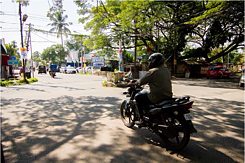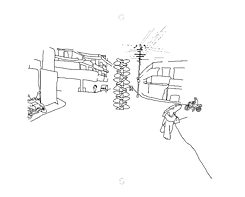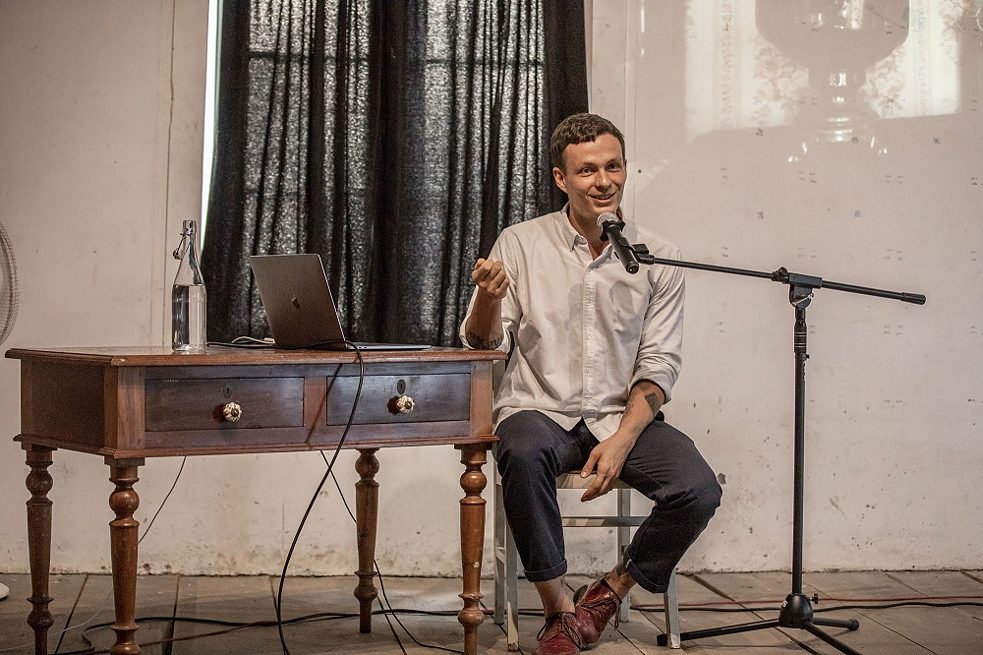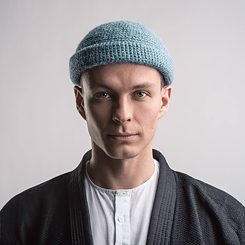For me, the
bangaloREsidency@Pepper House in Kochi, has become a quite unique experience of a very personal and meaningful kind.
Being a resident artist at the Pepper House for the duration of one month, the point of departure for my work was already predetermined in my project proposal. On the one hand, it was a return to and an artistic investigation of my hometown Kherson in South Ukraine, which I have left in the year 2000 to take refuge in Germany. This part of the overall project was accomplished several months in advance prior to the beginning of the residency. Here, the focus of the work was to research the reciprocal relationship between the shipyard of my hometown and the city part I grew up in, that is named “Satellite Island”. Accordingly, coming to Kochi several months later and arriving in a city with the largest shipbuilding facility in India, I was carrying a diversity of research outcomes in my suitcase with the aim to continue the work on site.
On the other hand, tailoring my residency project in this way, I wanted to review my material at the Pepper House for the first time to see whether, how and what these two shipbuilding places Kherson, Ukraine and
 © Kochi Biennale Foundation
© Kochi Biennale Foundation
Kochi, Kerala have in common. In this respect, the first ten days of my residency were focused on mapping out, editing and experimenting with the material I brought with me in order to allocate some rather precise points of contact between the two places. This in return meant that I did not need to start the project from scratch during the residency, but to communicate and share some questions and a plan of action together in a larger framework, along with the Goethe-Institut / Max Mueller Bhavan and Kochi-Muziris Biennale.
With tremendous support on both sides, my residency gave birth to the
After Joy project.
After Joy is a new global artwork consisting of a two-channel audio-visual installation and a sculpture in public space.
After Joy draws on the traces of four cargo ships: Vishwa Umang, Vishwa Tarang, Vishwa Asha and Vishwa Abha - Universal Joy, Wave, Hope and Grace - that were built at the shipyard in Kherson, Ukraine for India as a part of the Indo-Soviet Partnership in 1973 and 1974. The two-channel audio-visual installation and the
sculpture contextualise this exchange through the specificity of both sites – Kherson, in South Ukraine and Kochi, in Kerala, India.
In the reciprocal relationship with the sculpture, a two-channel video points towards the complexity of the current and future social, cultural and political trajectories of Ukraine and India, inviting the audience to position itself between the two and finalise the work introspectively. The installation includes the elements of work with radio and modular synthesis and consists of artistic interventions, research of archival materials and family archives, interviews with shipyard workers, labour unions and space programme scientists, and aerial footage on both sides.
The sculpture in the public space is constructed out of scrap propellers of seventy-inch radius put on top of
 © Kochi Biennale Foundation
© Kochi Biennale Foundation
each other in the centre of a roundabout in Kochi. Drawing on the current status of the 4 ships - “dead” or “lost” - the inactive propellers are animated by the rotation of the people around it. Inserted into the public space in this way, the sculpture begins with the material remains of the universal waves of joy, hope and grace and continues through a different form of circular motion allowing for a shift of attention towards the ephemerality of human intention and thrust.
Possessing a rather workaholic and process-driven nature, I have mostly engaged with the people and place through the work itself, that has allowed me to make new experiences, establish new networks and visit places related to my research. With the support of the Biennale team I was able to establish contact to Shipyard Workers Unions, speak to the Indian space programme scientists and to source large scrap propellers in order to transport and install these on the roundabout in Kochi, which in itself is already quite a significant and complex project in its own right. Furthermore, I was happy to meet and discover the place with other fellow artists working on sites and together with the larger Biennale Foundation team.
Throughout all of this quite enriching and beautiful journey the work has become both a harbinger pointing towards the current state of social and political affairs in the Ukraine and India, and also a very personal journey allowing me to pose integral questions of agency and intention within my own work. Observing the place I come from over this great distance and working through the similarities and differences has allowed for a very necessary and personal reflection on the place where my practice began, where I find myself now and where it is heading.
The latter especially can be traced in my residency experience through a series of experiments that include the installation of a functioning radio studio in my workspace, performance of live music scores and a performative presentation in the framework of the Let’s Talk Series organised by the Kochi Biennale Foundation, and a school workshop.
 © Kochi Biennale Foundation
© Kochi Biennale Foundation
I am really looking forward to travel back to Kochi in December of 2018 to attend the opening of the Kochi-Muziris Biennale during which the outcome of the residency will be presented.
This project has been made possible by diverse forms of collaboration, mutual support and tireless work. For this and more I would love to thank the Goethe-Institut / Max Mueller Bhavan - Maureen Gonsalves and Dr. Claus Heimes, the Kochi Biennale Foundation Team - Gautam Das and Naisam PS, Malabar House for its very generous hospitality and Pepper House for its amazing artist studio and its presence throughout the work.



